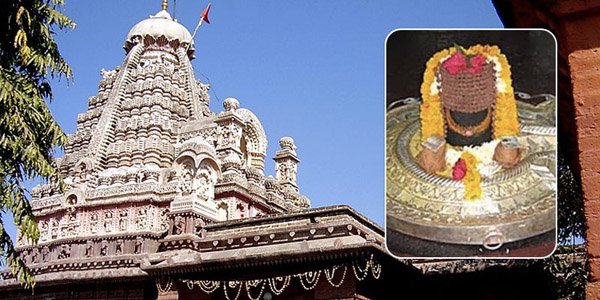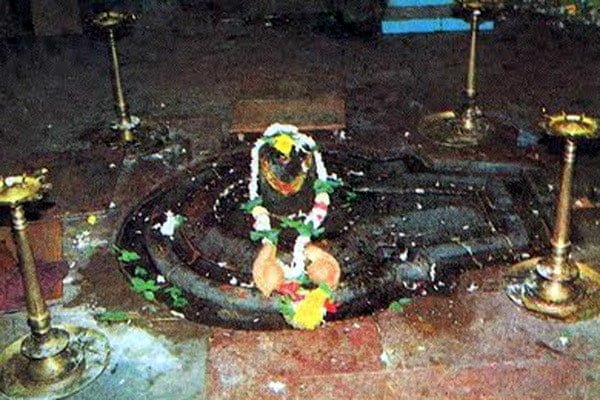Grishneshwar Temple is located in the Aurangabad district of Maharashtra. It is one of the favourite lists of 12 Jyotirlinga temples of Lord Shiva. The Grishneshwar Jyotirlinga is about 3000 years old and faces east of the lingam. The Grishneshwar temple timings are 5 AM to 9 PM.
Grishneshwar Temple
Contents
In the sanctum sanctorum are Grishneshwar and his wife, Ghrishneshwari. The Grishneshwar Temple is an excellent example of pre-historic architectural style and has beautiful carvings. Devotees can see God and his wife’s wedding scene in the temple murals and carvings.

Significance of the Temple
Ghrishneshwara Jyotirlinga was adorned with flowers and sacred Rudraksha beads. The importance of the Temple is that the pilgrims believe that by visiting the Grishneshwar Temple, 12 Jyotirlingas worshipped. The Grishneshwar Temple also has a well where holy water flows. The Temple has a holy kund (sacred pot).
History of Grishneshwar Jyotirlinga
The history of Grishneshwar Temple tells of Maloji Bhosle, a great devotee and village chief of Verul. He built the mandir in the 16th century after finding a hidden treasure in a mound.
The Temple was restored in the 17th century by Rani Ahilyabai Holkar of the Maratha Malwa kingdom. According to Shiva Purana, many legends are associated with this ancient place of worship:
Shivalaya Purana
Shivalaya Purana states that during his hunting expeditions, King Verul killed the animals that lived in the monastery of the sages—angered the sages, who cursed the king and surrounded his body with insects.

The king wandered into the forest and saw a hole through which water flowed. The insects miraculously disappeared from his body when the king started drinking the water.
The overflowing king performed hard penance in that place. Delighted with penance, Lord Brahma blessed the king and created a lake called Shivalaya.
The Legend of Kunkumeshwar
Lord Shiva and his wife lived near the Shiva temple in the Sahyadri mountain range. As Goddess Vermilion was about to pour one day, she mixed it in the Lord Shiva temple water.
Vermilion transformed into a linga, emitting a ray of bright light. Since the lingam originated from Vermilion, this Jyotirlinga was initially known as Kunkumeshwar.
But the goddess named it Grishneshwar as it comes from lingam massage, and the word Grish means abrasion.
The legend of Ghushmeshwar
It is the story of a great Brahmin scholar, Brahmavetta Sudharm, and his wife, Sudeha, who lived on the southern mountain of Devagiri (later known as Daulatabad).
They have no children, and the tormented Sudeha persuades his sister Ghushma to marry Sudharma to have a child together.
Eventually, Ghushma and Sudharm gave birth to a son who was jealous of Sudeha. The boy grew up a smart and handsome young man and eventually married.
Unable to bear the jealousy, Sudeha killed the sleeping boy and dumped his body in the lake. Gushma, who was in deep grief, continued her daily routine.
During the morning ritual of visiting the lake, where she usually makes a hundred lingas and worships, she saw her son coming out of the lake. Then Lord Shiva appeared in front of her and said that Sudeha had killed his son.
Gushma rejoiced in the devotion, and he gave back her son and gave her a boon. Ghushma then forgave his sister and asked the Lord to stay in that place.
God accepted her request and lived there in the form of Jyotirlinga. Hence, he took the name Ghushmeshwar in honour of Gushma.
The architecture of Grishneshwar Temple
Grishneshwar Mandir is carved out of red stone and is a feast for lovers of ancient architecture.
The Temple attracts history buffs as the stone sculptures of many Maratha heroes are beautiful preserves in the Temple. Devotees and visitors can marvel at the magnificent five-tiered peak (temple dome).

Shikara also has intricate carvings of Dashavatar, which can glisten in the red volcanic rock. Devotees are also amazed by the statue of Nandikeswara that adorns the court hall.
Festivals Celebrate at Grishneshwar Jyotirlinga
Some of the festivals celebrated at the Temple are:
Mahashivaratri: Like all the important Shiva temples, the Maha Shivaratri festival at the Grishneshwar Temple is great. It is the main festival here. Hundreds of devotees visit this town yearly on this auspicious February / March.
Ganesh Chaturthi: This festival dedicated to Lord Ganesha celebrates August / September.
Navratri or Durga Puja: A famous festival celebrated as a symbol of victory over good over evil.
According to legend, Goddess Durga defeated the demon king Mahishasura to save the world and restore Dharma. Navratri celebrates for nine days across India.
Celebrations at the Temple include stage decorations, reading of Puranas, storytelling and recitation of Hindu scriptures.
Nearby Temples
Ellora Caves are a popular tourist attraction near Aurangabad. Some temples near Grishneshwar:
Ellora Caves: Ellora Caves are a collection of Hindu, Buddhist, and Jain caves and an excellent example of religious harmony in ancient times. Ellora Caves is located 1 km from the Grishneshwar Temple.
Bhadra Maruti Temple, Kuldabad: This Temple is dedicated to the ape god Hanuman. Bhadra Maruti Temple is the only Temple dedicated to Lord Hanuman. The Temple is located at a distance of just 6 km from the Temple.
Aundha Nagnath Jyotirlinga Temple: The Aundha Temple in the village of Aundha Nagnath in Maharashtra is the first of the Jyotirlinga temples. The Temple is located at a distance of 227 km from the Grishneshwar Temple. According to beliefs, Yudhishthira, the eldest of the Pandavas brothers, built the Temple during their exile.
Bhimashankar Temple: The Bhimashankar Jyotirlinga Temple is near Pune and 201 km from the Temple. The lingam is one of the five Jyotirlingas in Maharashtra.
Parli Vaijanath Jyotirlinga Temple: Vaijanath Jyotirlinga Temple is located in Parli, Beed district in Maharashtra. The Temple is located 246 km from the Temple. Moreover, devotees believe that worshipping at this Temple improves their health.
Trimbakeshwar Jyotirlinga Temple: Trimbakeshwar Temple is located in Trimbak, Nashik District in Maharashtra. The Temple is located 214 km from the Temple. The linga has three faces symbolising Shiva, Vishnu and Brahma.
Grishneshwar Temple timings
Below are the Grishneshwar temple timings
| Rituals | Grishneshwar Temple Timings |
| morning Darshan | 5:30 AM – 9:30 PM |
| Darshan during Shravana Maas | 3:00 AM – 11:00 PM |
| Noon Pooja | 1:00 PM – 1:30 PM |
| Evening Pooja | 4:00 PM – 5:30 PM |
How to reach
Air:
The nearest airport is Aurangabad, which has regular flights from Delhi, Mumbai, Jaipur, and Udaipur.
Train:
The nearest railway station is Aurangabad. Manmad is also closer and better connected.
Road:
From Pune: 256 km / 4.5 hrs. Nashik: 187 km / 3 hrs. Shirdi: 122 km / 2.5 hrs.
Contact number
094227 14345
FAQs
Where should it be near the Grishneshwar temple?
Grishneshwar Temple is located in a small village called Verul, and many accommodation options are unavailable nearby. Devotees usually stay in Daulatabad or Aurangabad, which provides more accommodation. You can expect more budget accommodation in Daulatabad.
Where to eat in Grishneshwar Jyotirlinga?
Many devotees have a free meal at the Temple. There are not many restaurant options in Verul. However, there are many good independent restaurants in Aurangabad.